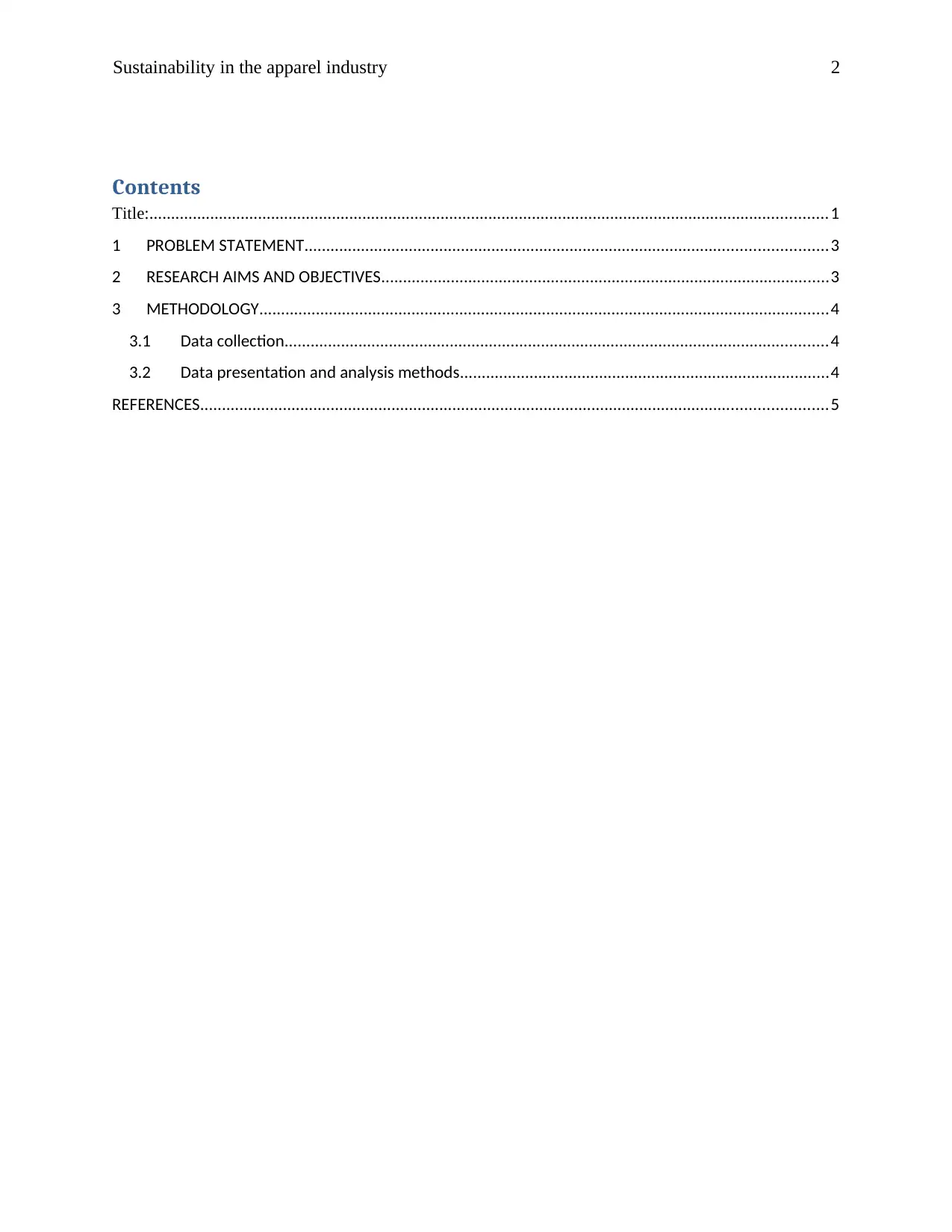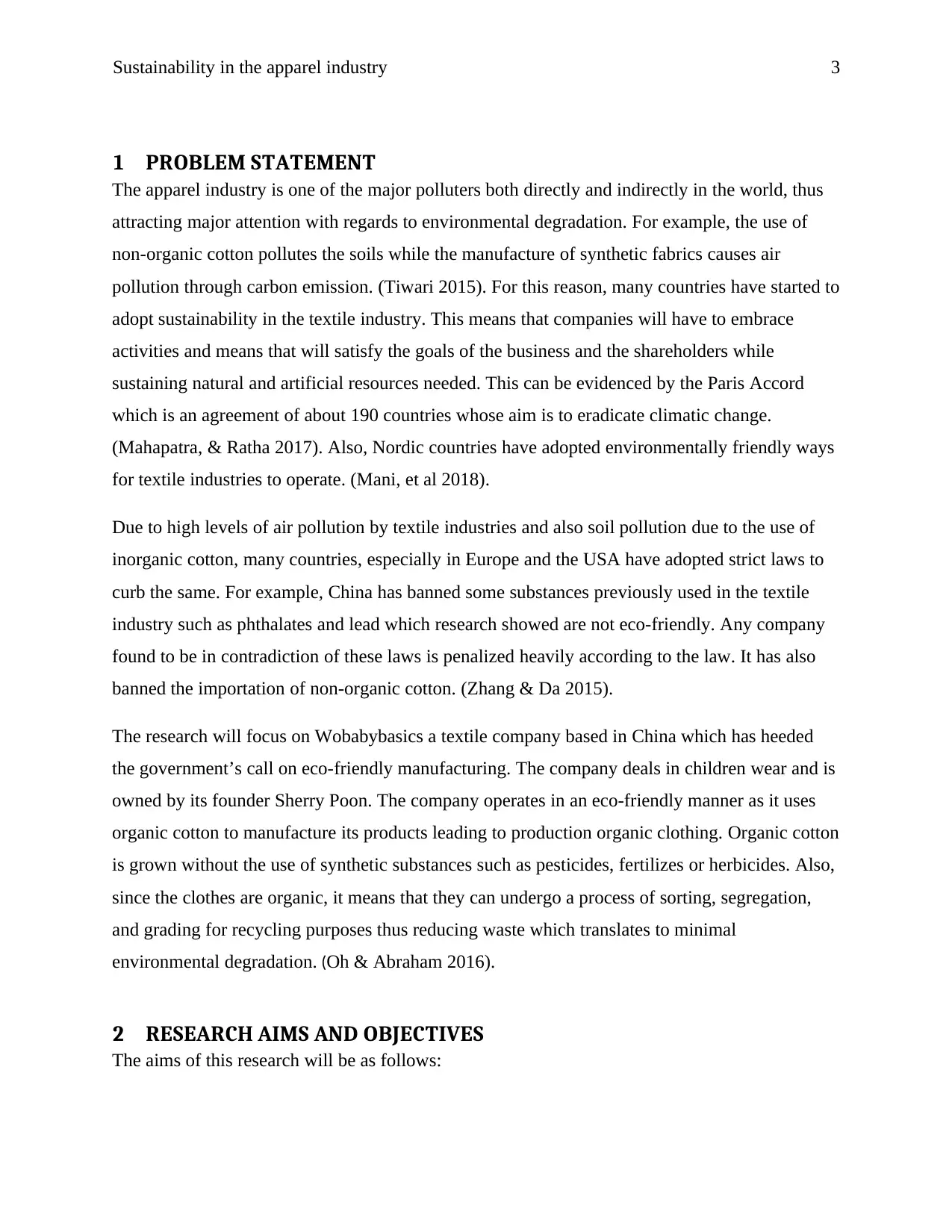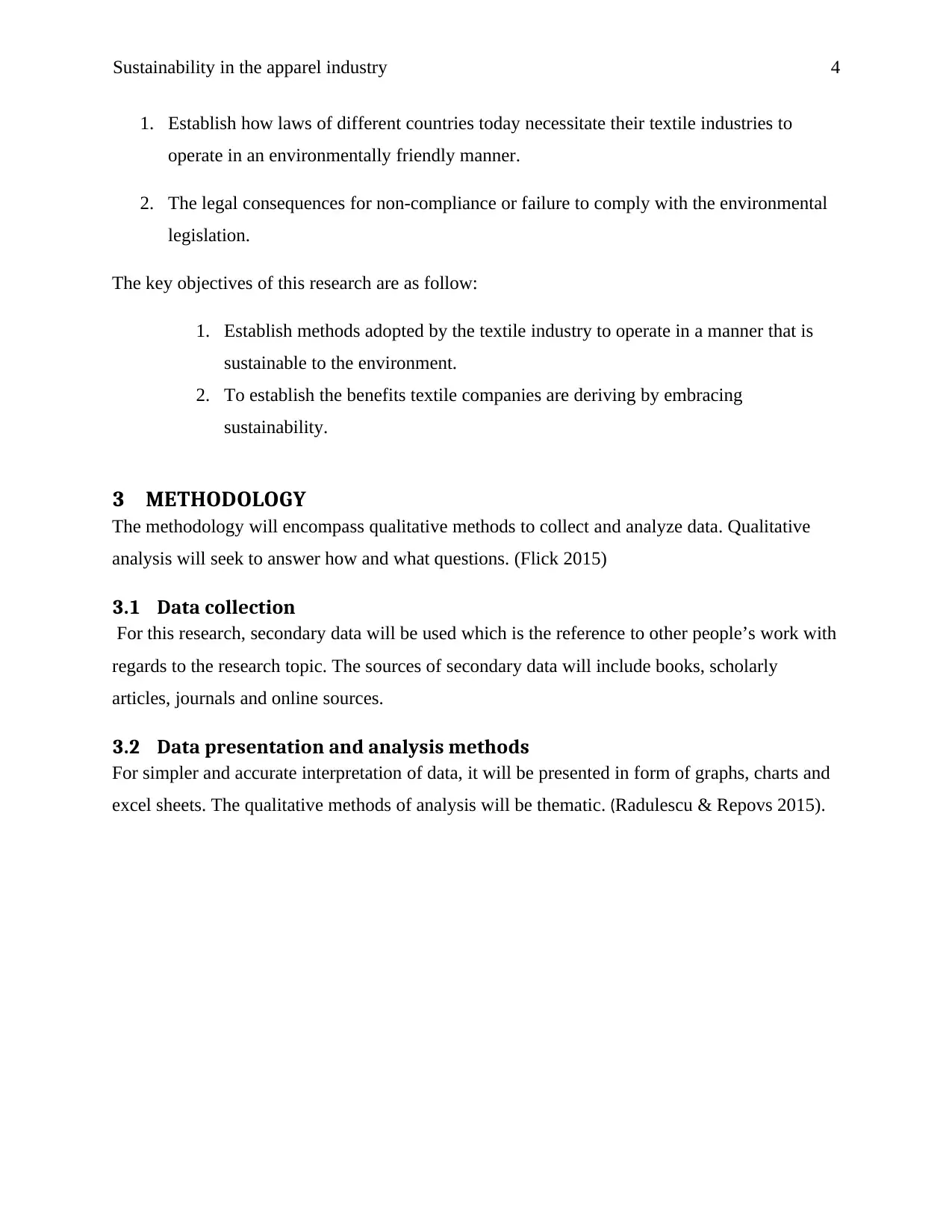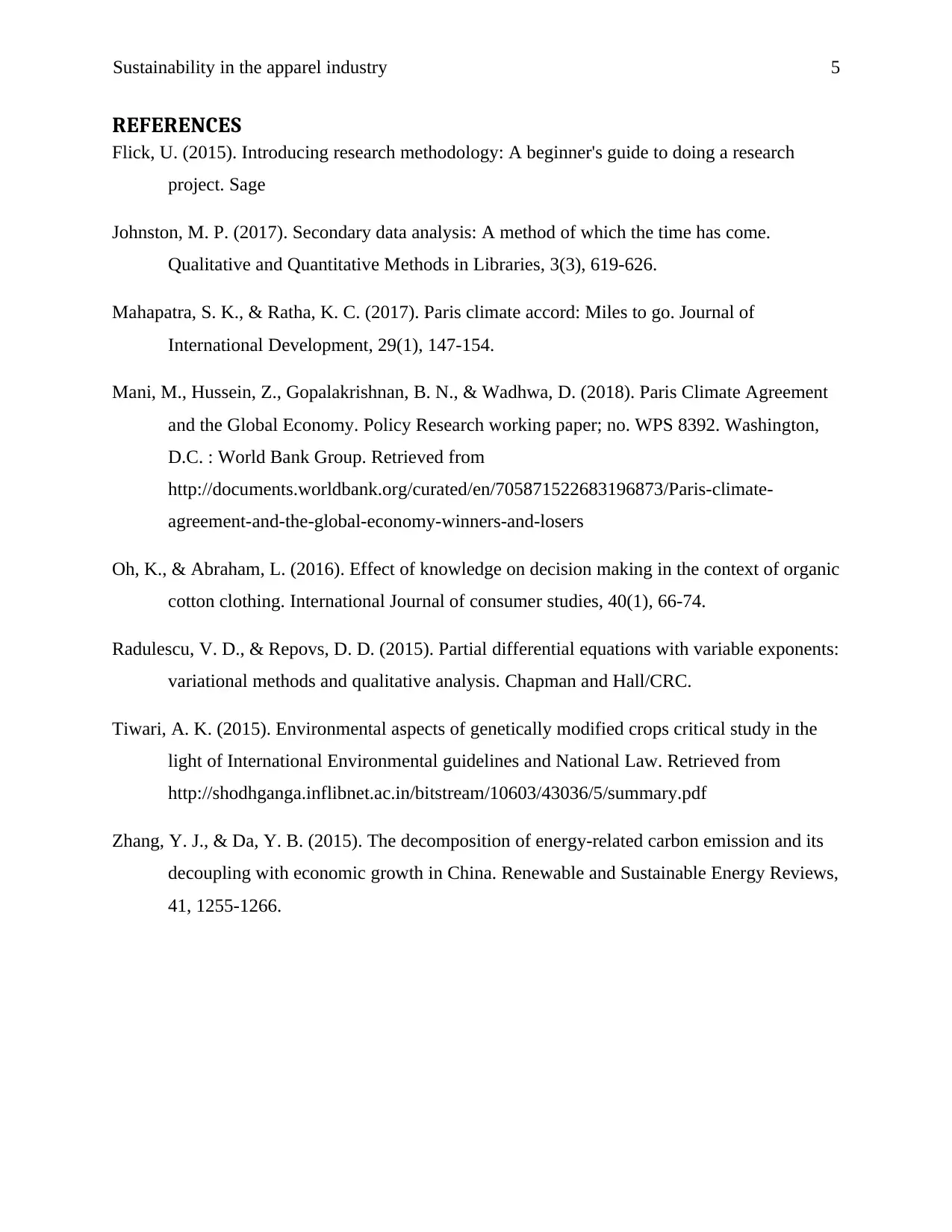Sustainability in the Apparel Industry: Laws, Compliance, and Benefits
VerifiedAdded on 2023/06/08
|5
|957
|440
Project
AI Summary
This project outline addresses the critical issue of sustainability in the apparel industry, highlighting its significant environmental impact and the growing need for eco-friendly practices. It examines how various countries are enacting laws to ensure textile industries operate sustainably, focusing on the legal consequences of non-compliance. The research aims to identify methods adopted by the textile industry to minimize environmental impact and the benefits companies derive from embracing sustainability. The methodology employs qualitative methods, using secondary data from books, scholarly articles, journals, and online sources, with data analysis utilizing thematic approaches and presentation through graphs, charts, and excel sheets. The project refers to Wobabybasics, a China-based children's wear company, as an example of a business successfully implementing eco-friendly manufacturing through the use of organic cotton.

Running header
Title:
Name:
Lecturer:
Institution
Title:
Name:
Lecturer:
Institution
Paraphrase This Document
Need a fresh take? Get an instant paraphrase of this document with our AI Paraphraser

Sustainability in the apparel industry 2
Contents
Title:............................................................................................................................................................1
1 PROBLEM STATEMENT........................................................................................................................3
2 RESEARCH AIMS AND OBJECTIVES.......................................................................................................3
3 METHODOLOGY...................................................................................................................................4
3.1 Data collection.............................................................................................................................4
3.2 Data presentation and analysis methods.....................................................................................4
REFERENCES................................................................................................................................................5
Contents
Title:............................................................................................................................................................1
1 PROBLEM STATEMENT........................................................................................................................3
2 RESEARCH AIMS AND OBJECTIVES.......................................................................................................3
3 METHODOLOGY...................................................................................................................................4
3.1 Data collection.............................................................................................................................4
3.2 Data presentation and analysis methods.....................................................................................4
REFERENCES................................................................................................................................................5

Sustainability in the apparel industry 3
1 PROBLEM STATEMENT
The apparel industry is one of the major polluters both directly and indirectly in the world, thus
attracting major attention with regards to environmental degradation. For example, the use of
non-organic cotton pollutes the soils while the manufacture of synthetic fabrics causes air
pollution through carbon emission. (Tiwari 2015). For this reason, many countries have started to
adopt sustainability in the textile industry. This means that companies will have to embrace
activities and means that will satisfy the goals of the business and the shareholders while
sustaining natural and artificial resources needed. This can be evidenced by the Paris Accord
which is an agreement of about 190 countries whose aim is to eradicate climatic change.
(Mahapatra, & Ratha 2017). Also, Nordic countries have adopted environmentally friendly ways
for textile industries to operate. (Mani, et al 2018).
Due to high levels of air pollution by textile industries and also soil pollution due to the use of
inorganic cotton, many countries, especially in Europe and the USA have adopted strict laws to
curb the same. For example, China has banned some substances previously used in the textile
industry such as phthalates and lead which research showed are not eco-friendly. Any company
found to be in contradiction of these laws is penalized heavily according to the law. It has also
banned the importation of non-organic cotton. (Zhang & Da 2015).
The research will focus on Wobabybasics a textile company based in China which has heeded
the government’s call on eco-friendly manufacturing. The company deals in children wear and is
owned by its founder Sherry Poon. The company operates in an eco-friendly manner as it uses
organic cotton to manufacture its products leading to production organic clothing. Organic cotton
is grown without the use of synthetic substances such as pesticides, fertilizes or herbicides. Also,
since the clothes are organic, it means that they can undergo a process of sorting, segregation,
and grading for recycling purposes thus reducing waste which translates to minimal
environmental degradation. (Oh & Abraham 2016).
2 RESEARCH AIMS AND OBJECTIVES
The aims of this research will be as follows:
1 PROBLEM STATEMENT
The apparel industry is one of the major polluters both directly and indirectly in the world, thus
attracting major attention with regards to environmental degradation. For example, the use of
non-organic cotton pollutes the soils while the manufacture of synthetic fabrics causes air
pollution through carbon emission. (Tiwari 2015). For this reason, many countries have started to
adopt sustainability in the textile industry. This means that companies will have to embrace
activities and means that will satisfy the goals of the business and the shareholders while
sustaining natural and artificial resources needed. This can be evidenced by the Paris Accord
which is an agreement of about 190 countries whose aim is to eradicate climatic change.
(Mahapatra, & Ratha 2017). Also, Nordic countries have adopted environmentally friendly ways
for textile industries to operate. (Mani, et al 2018).
Due to high levels of air pollution by textile industries and also soil pollution due to the use of
inorganic cotton, many countries, especially in Europe and the USA have adopted strict laws to
curb the same. For example, China has banned some substances previously used in the textile
industry such as phthalates and lead which research showed are not eco-friendly. Any company
found to be in contradiction of these laws is penalized heavily according to the law. It has also
banned the importation of non-organic cotton. (Zhang & Da 2015).
The research will focus on Wobabybasics a textile company based in China which has heeded
the government’s call on eco-friendly manufacturing. The company deals in children wear and is
owned by its founder Sherry Poon. The company operates in an eco-friendly manner as it uses
organic cotton to manufacture its products leading to production organic clothing. Organic cotton
is grown without the use of synthetic substances such as pesticides, fertilizes or herbicides. Also,
since the clothes are organic, it means that they can undergo a process of sorting, segregation,
and grading for recycling purposes thus reducing waste which translates to minimal
environmental degradation. (Oh & Abraham 2016).
2 RESEARCH AIMS AND OBJECTIVES
The aims of this research will be as follows:
⊘ This is a preview!⊘
Do you want full access?
Subscribe today to unlock all pages.

Trusted by 1+ million students worldwide

Sustainability in the apparel industry 4
1. Establish how laws of different countries today necessitate their textile industries to
operate in an environmentally friendly manner.
2. The legal consequences for non-compliance or failure to comply with the environmental
legislation.
The key objectives of this research are as follow:
1. Establish methods adopted by the textile industry to operate in a manner that is
sustainable to the environment.
2. To establish the benefits textile companies are deriving by embracing
sustainability.
3 METHODOLOGY
The methodology will encompass qualitative methods to collect and analyze data. Qualitative
analysis will seek to answer how and what questions. (Flick 2015)
3.1 Data collection
For this research, secondary data will be used which is the reference to other people’s work with
regards to the research topic. The sources of secondary data will include books, scholarly
articles, journals and online sources.
3.2 Data presentation and analysis methods
For simpler and accurate interpretation of data, it will be presented in form of graphs, charts and
excel sheets. The qualitative methods of analysis will be thematic. (Radulescu & Repovs 2015).
1. Establish how laws of different countries today necessitate their textile industries to
operate in an environmentally friendly manner.
2. The legal consequences for non-compliance or failure to comply with the environmental
legislation.
The key objectives of this research are as follow:
1. Establish methods adopted by the textile industry to operate in a manner that is
sustainable to the environment.
2. To establish the benefits textile companies are deriving by embracing
sustainability.
3 METHODOLOGY
The methodology will encompass qualitative methods to collect and analyze data. Qualitative
analysis will seek to answer how and what questions. (Flick 2015)
3.1 Data collection
For this research, secondary data will be used which is the reference to other people’s work with
regards to the research topic. The sources of secondary data will include books, scholarly
articles, journals and online sources.
3.2 Data presentation and analysis methods
For simpler and accurate interpretation of data, it will be presented in form of graphs, charts and
excel sheets. The qualitative methods of analysis will be thematic. (Radulescu & Repovs 2015).
Paraphrase This Document
Need a fresh take? Get an instant paraphrase of this document with our AI Paraphraser

Sustainability in the apparel industry 5
REFERENCES
Flick, U. (2015). Introducing research methodology: A beginner's guide to doing a research
project. Sage
Johnston, M. P. (2017). Secondary data analysis: A method of which the time has come.
Qualitative and Quantitative Methods in Libraries, 3(3), 619-626.
Mahapatra, S. K., & Ratha, K. C. (2017). Paris climate accord: Miles to go. Journal of
International Development, 29(1), 147-154.
Mani, M., Hussein, Z., Gopalakrishnan, B. N., & Wadhwa, D. (2018). Paris Climate Agreement
and the Global Economy. Policy Research working paper; no. WPS 8392. Washington,
D.C. : World Bank Group. Retrieved from
http://documents.worldbank.org/curated/en/705871522683196873/Paris-climate-
agreement-and-the-global-economy-winners-and-losers
Oh, K., & Abraham, L. (2016). Effect of knowledge on decision making in the context of organic
cotton clothing. International Journal of consumer studies, 40(1), 66-74.
Radulescu, V. D., & Repovs, D. D. (2015). Partial differential equations with variable exponents:
variational methods and qualitative analysis. Chapman and Hall/CRC.
Tiwari, A. K. (2015). Environmental aspects of genetically modified crops critical study in the
light of International Environmental guidelines and National Law. Retrieved from
http://shodhganga.inflibnet.ac.in/bitstream/10603/43036/5/summary.pdf
Zhang, Y. J., & Da, Y. B. (2015). The decomposition of energy-related carbon emission and its
decoupling with economic growth in China. Renewable and Sustainable Energy Reviews,
41, 1255-1266.
REFERENCES
Flick, U. (2015). Introducing research methodology: A beginner's guide to doing a research
project. Sage
Johnston, M. P. (2017). Secondary data analysis: A method of which the time has come.
Qualitative and Quantitative Methods in Libraries, 3(3), 619-626.
Mahapatra, S. K., & Ratha, K. C. (2017). Paris climate accord: Miles to go. Journal of
International Development, 29(1), 147-154.
Mani, M., Hussein, Z., Gopalakrishnan, B. N., & Wadhwa, D. (2018). Paris Climate Agreement
and the Global Economy. Policy Research working paper; no. WPS 8392. Washington,
D.C. : World Bank Group. Retrieved from
http://documents.worldbank.org/curated/en/705871522683196873/Paris-climate-
agreement-and-the-global-economy-winners-and-losers
Oh, K., & Abraham, L. (2016). Effect of knowledge on decision making in the context of organic
cotton clothing. International Journal of consumer studies, 40(1), 66-74.
Radulescu, V. D., & Repovs, D. D. (2015). Partial differential equations with variable exponents:
variational methods and qualitative analysis. Chapman and Hall/CRC.
Tiwari, A. K. (2015). Environmental aspects of genetically modified crops critical study in the
light of International Environmental guidelines and National Law. Retrieved from
http://shodhganga.inflibnet.ac.in/bitstream/10603/43036/5/summary.pdf
Zhang, Y. J., & Da, Y. B. (2015). The decomposition of energy-related carbon emission and its
decoupling with economic growth in China. Renewable and Sustainable Energy Reviews,
41, 1255-1266.
1 out of 5
Related Documents
Your All-in-One AI-Powered Toolkit for Academic Success.
+13062052269
info@desklib.com
Available 24*7 on WhatsApp / Email
![[object Object]](/_next/static/media/star-bottom.7253800d.svg)
Unlock your academic potential
Copyright © 2020–2025 A2Z Services. All Rights Reserved. Developed and managed by ZUCOL.





